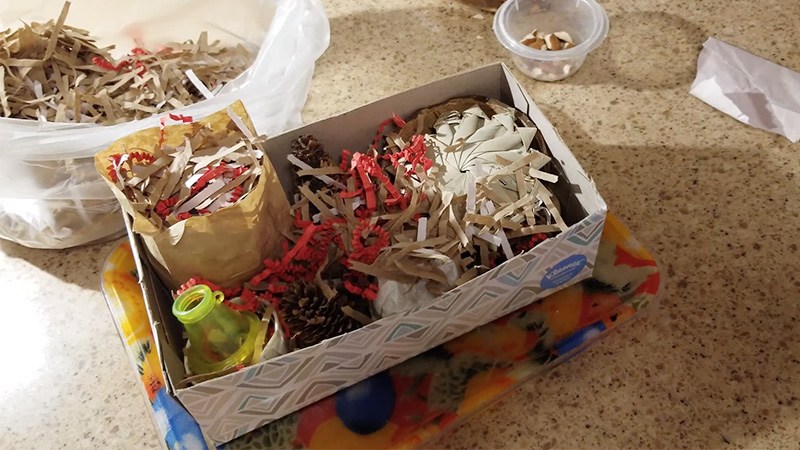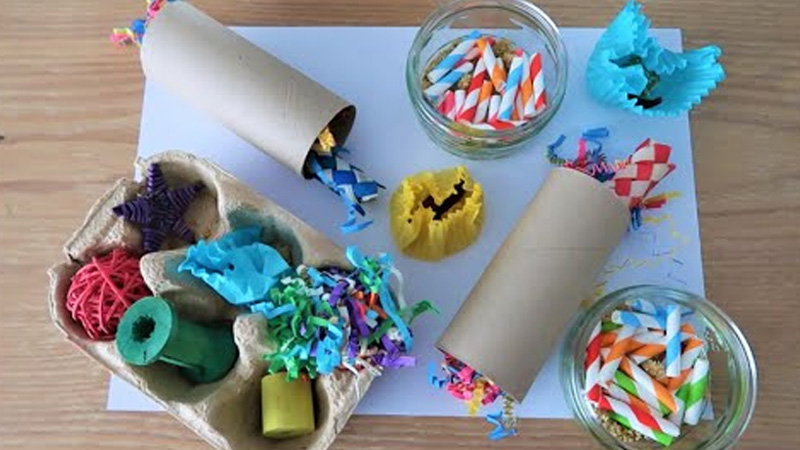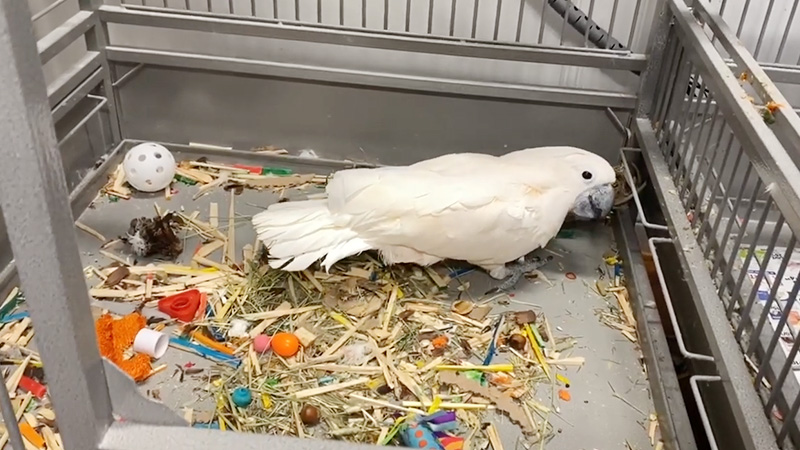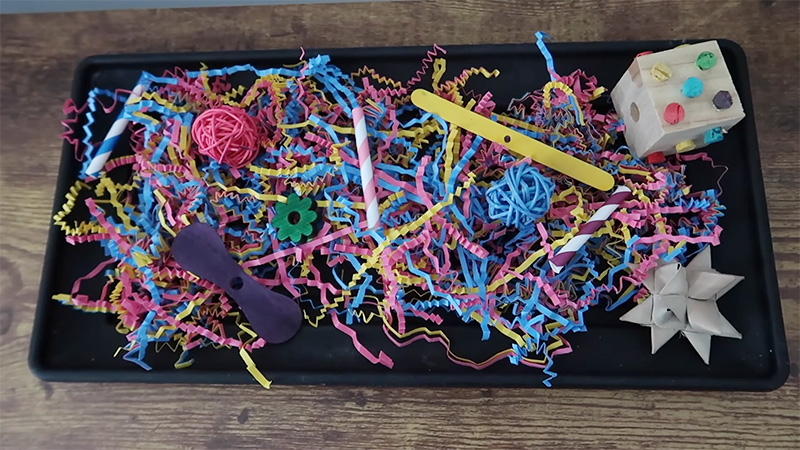Parrot foraging boxes are a fantastic way to provide mental stimulation and engage the instincts of your feathered friend. By creating a parrot foraging box, you can offer your parrot a fun and interactive experience while encouraging its foraging behaviours.
In this guide, we will explore step-by-step instructions on how to make a parrot foraging box, allowing you to enhance your parrot’s enrichment and well-being.

How To Make A Parrot Foraging Box? Step By Step Guideline
Creating a parrot foraging box is an excellent way to engage your feathered friend and stimulate their instincts. Here’s a step-by-step guideline to help you make a parrot foraging box:
Materials you will need:
- A sturdy cardboard or wooden box (choose a size suitable for your parrot)
- Non-toxic glue or adhesive
- Natural fibres (such as untreated sisal rope or twine)
- Parrot-safe toys and objects for hiding treats (wooden blocks, bells, plastic rings, etc.)
- Bird-safe treats or food items (nuts, dried fruits, bird pellets, etc.)
- Non-toxic food colouring (optional)
- Scissors or a utility knife
- Hole punch or a sharp object for creating openings
Step 1:
Prepare the Box. Choose a box that is large enough for your parrot to navigate comfortably. Remove any tape or staples from the box and ensure no sharp edges or loose pieces could harm your bird.
Cut any flaps or excess material from the box, leaving it open at the top.
Step 2:
Create Openings Using a hole punch or a sharp object, create openings of various sizes on the sides and top of the box. These holes will serve as access points for your parrot to retrieve the treats.
Ensure the holes are large enough for your parrot’s beak to fit through but not too large so the treats fall out easily.
Step 3:
Add Natural Fibers. Cut pieces of untreated sisal rope or twine into various lengths. Glue or tie these fibres inside the box, creating a network of ropes and knots. Parrots enjoy manipulating and chewing on natural fibres, and this will add an extra element of exploration to the foraging box.
Step 4:
Incorporate Toys and Objects. Place parrot-safe toys and objects inside the box. Wooden blocks, bells, plastic rings, and other bird toys can be fastened or glued to the sides or bottom of the box.
These objects will provide additional mental and physical stimulation for your parrot.
Step 5:
Food and Treat Placement Place bird-safe treats or food items inside the box. Nuts, dried fruits, bird pellets, or parrot-friendly treats can be hidden within the box’s compartments.
Add a few drops of non-toxic food colouring to make the treats more visually appealing for your parrot.
Step 6:
Secure the Box Ensure that all glued or tied objects are securely attached to the box. Parrots are intelligent and strong, so ensure everything is well-fastened to avoid accidents or choking hazards.
Double-check that no loose or sharp objects could harm your parrot.
Step 7:
Introduce the Foraging Box Present the foraging box to your parrot in their play area or cage. Observe how they interact with it and encourage them to explore and find the hidden treats. Initially, you may need to demonstrate how to retrieve the treats through the openings.
Over time, your parrot will learn to enjoy the challenge of finding rewards in the foraging box.
Remember to periodically change the treats and toys inside the foraging box to keep your parrot’s interest high. Supervise your parrot during playtime with the foraging box to ensure their safety and well-being.
What Is A Parrot Foraging Box?

A parrot foraging box is a specially designed toy or container encouraging parrots to engage in natural foraging behaviours. It is created to stimulate the bird’s intellect and provide mental and physical enrichment.
The foraging box typically consists of a container with various compartments, openings, and hiding spots where treats or food items can be concealed.
Parrots are intelligent and curious creatures in the wild, spending significant time searching for food.
However, in captivity, they often lack opportunities to exhibit these natural foraging behaviours. A foraging box aims to replicate the foraging experience by challenging the parrot to explore, problem-solve, and retrieve hidden rewards.
The design of a parrot foraging box can vary. Still, it usually involves a sturdy container, such as a cardboard or wooden box, with multiple holes, compartments, or puzzles that require the parrot to manipulate objects or use its beak and claws to access the treats.
The box may also contain various textures, natural fibres, and bird-safe toys to engage the parrot’s senses further and provide a more enriching experience.
By using a foraging box, parrots are encouraged to exercise their instincts, alleviate boredom, and reduce the likelihood of behavioural issues that may arise from a lack of mental and physical stimulation.
It also provides an excellent opportunity for parrot-human interaction, as owners can observe and participate in the parrot’s foraging activities, strengthening the bond between the bird and its caregiver.
Why Is Foraging Important For Parrots?

Foraging is essential for parrots due to the following reasons:
Mental Stimulation
Parrots are brilliant animals that require mental stimulation to thrive. Foraging engages their problem-solving abilities, memory, and decision-making skills.
Presenting them with challenging tasks, such as finding hidden treats or manipulating objects, foraging exercises their cognitive abilities, preventing boredom, and providing a sense of accomplishment.
Physical Exercise
Parrots spend a lot of time and energy foraging for food in the wild. This activity involves flying, climbing, and exploring their environment. In captivity, parrots often have limited opportunities for physical exercise, leading to potential health issues.
Foraging boxes encourage movement as parrots navigate the compartments, manipulate objects, and retrieve treats. The physical activity associated with foraging helps maintain muscle tone and overall fitness and prevents obesity.
Behavioural Enrichment
Parrots are active and curious creatures. They can develop behavioural problems such as excessive vocalization, feather plucking, or destructive behaviours without appropriate mental and physical stimulation.
Foraging provides an outlet for their instincts and helps prevent boredom and frustration. Parrots are less likely to engage in undesirable behaviours by engaging in stimulating activities like foraging.
Natural Instinct Fulfillment
Foraging is an innate behaviour for parrots. In the wild, they spend a significant portion of their time searching for food, manipulating objects, and problem-solving. By providing opportunities for foraging in captivity, we fulfil their instincts and allow them to express their natural behaviours.
This helps promote their overall well-being and contributes to their psychological health.
Bonding and Trust
Foraging activities can be a shared experience between parrots and their caregivers. Owners can strengthen their bond with their feathered companion by participating in the parrot’s foraging sessions, providing treats, and interacting with them during the process.
Parrots learn to associate the caregiver with positive experiences and develop trust, which is crucial for their social and emotional development.
In summary, foraging is important for parrots as it provides mental stimulation, physical exercise, and behavioural enrichment, fulfils their instincts, and strengthens the bond between the bird and its caregiver.
Incorporating foraging activities, such as foraging boxes, into a parrot’s daily routine effectively promotes their overall well-being and ensures they lead fulfilling lives in captivity.
What Do You Put In A Foraging Tray For Birds?

When preparing a foraging tray for birds, it’s important to include a variety of items that will engage their senses and stimulate their natural foraging instincts.
Here are some suggestions on what to put in a foraging tray for birds:
Shredded Paper or Natural Bedding
Start by adding a layer of shredded paper or natural bedding material as the base of the foraging tray. This creates a texture that birds can dig through and helps mimic the leaf litter they would encounter in the wild.
Foraging Substrates
Incorporate different foraging substrates, such as untreated wood chips, straws, dried leaves, or small twigs. These materials provide additional texture and encourage birds to explore and forage through them.
Fresh or Edible Greens
Place fresh greens or edible herbs in the tray. Birds, particularly parrots, enjoy nibbling on leaves and sprouts. Include bird-safe options like kale, dandelion greens, parsley, or edible flowers.
These provide nutritional value and an additional foraging challenge as birds navigate the greens to find other hidden treats.
Puzzle Toys and Foraging Devices
Introduce bird-safe puzzle toys or foraging devices into the tray. These can include treat-dispensing balls, puzzle boxes, or hanging foraging toys.
Place treats or pellets inside these devices to encourage birds to manipulate and solve the puzzles to access the rewards.
Nutritional Treats and Chews
Hide bird-safe treats, such as pieces of dried fruits, nuts, or seeds, within the substrate or in small containers. Make sure to use goodies suitable for your bird’s diet and size.
You can also include bird-safe chew toys made of untreated wood or natural fibres to provide a satisfying chewing experience.
Food-Scattered Surfaces
Sprinkle or scatter small portions of your bird’s regular food or pellets throughout the foraging tray. This encourages birds to search and forage for their meals actively rather than having food readily available in a bowl.
It mimics their natural feeding behaviours and adds an element of mental and physical stimulation.
Novel Objects and Natural Materials
Add bird-safe and natural materials to the foraging tray. This can include small wicker balls, cardboard tubes, bells, or even dried palm fronds.
Birds enjoy exploring new textures and objects, and these items provide additional enrichment and foraging opportunities.
Remember to observe your bird’s preferences and adjust the contents of the foraging tray accordingly. Monitor the tray regularly, remove any spoiled or soiled items, and replace them with fresh materials to maintain cleanliness and safety.
Offering a diverse range of things in the foraging tray will keep your bird mentally engaged and physically active and provide a fulfilling foraging experience.
How To Teach Your Parrot To Start Foraging?
Teaching your parrot to start foraging can be an enjoyable and rewarding experience for you and your feathered friend. Here are some instructions to help you get started:
Introduce Foraging Toys
Introduce your parrot to foraging toys designed for beginners. Choose toys that are easy to manipulate and have compartments to place treats or food items.
Show the toy to your parrot and encourage them to explore it by demonstrating how to open compartments or retrieve treats.
Hide Treats in Plain Sight
Initially, make it easy for your parrot to find treats by placing them in plain sight. For example, attach small charms to the outside of the foraging toy or place them near the openings.
This helps your parrot associate the toy with rewards and encourages them to investigate further.
Gradually Increase Difficulty
As your parrot becomes more comfortable with the concept of foraging, gradually increase the difficulty level. Hide treats inside the compartments of the toy or use toys with more challenging mechanisms.
This encourages your parrot to problem-solve and work harder to retrieve the rewards.
Vary the Treats and Toys
To keep your parrot engaged and interested, vary the treats and toys you use for foraging. Introduce different textures, tastes, and sizes of treats, and rotate between different types of foraging toys.
This prevents boredom and maintains your parrot’s enthusiasm for foraging.
Provide Verbal and Physical Encouragement
Throughout the training process, provide positive reinforcement and encouragement to your parrot. Use verbal cues such as “Find the treat” or “Forage!” to associate the activity with a command.
Additionally, offer praise, gentle petting, or a favourite treat when your parrot successfully retrieves a hidden reward.
Set a Foraging Routine
Establish a routine by incorporating regular foraging sessions into your parrot’s daily schedule. Consistency is key to reinforcing the behaviour and helping your parrot develop a foraging habit.
Start with shorter sessions and gradually increase the duration as your parrot becomes more adept at foraging.
Expand Foraging Opportunities
Once your parrot has grasped the concept of foraging, expand the opportunities beyond toys. Create DIY foraging experiences by hiding treats in different areas of their enclosure or using natural materials like cardboard boxes, paper rolls, or woven baskets.
Supervise your parrot during these activities to ensure their safety.
Remember, each parrot is unique, and the learning process may vary. Be patient and observe your parrot’s preferences and progress. Some parrots may take to foraging quickly, while others may require more time and guidance.
Enjoy the journey of teaching your parrot to forage and celebrate their accomplishments along the way.
FAQ
To make a parrot foraging box, you will need a sturdy cardboard or wooden box, non-toxic glue or adhesive, natural fibres like untreated sisal rope or twine, parrot-safe toys and objects, bird-safe treats or food items, non-toxic food colouring (optional), scissors or a utility knife, and a hole punch or a sharp object for creating openings.
You can create openings in the foraging box by using a hole punch or a sharp object. Make sure the holes are large enough for your parrot’s beak to fit through but not too large that the treats fall out easily.
You can also create various sizes of openings on the sides and top of the box to provide different challenges for your parrot.
It’s important to use bird-safe treats or food items in the foraging box. You can include nuts, dried fruits, bird pellets, or other parrot-friendly treats. Ensure that the treats are suitable for your parrot’s diet and size.
You can also consider adding a few drops of non-toxic food colouring to make the treats more visually appealing for your parrot.
It’s essential to use parrot-safe toys in the foraging box. Look for toys made specifically for birds, such as wooden blocks, bells, plastic rings, or other objects that are safe for them to chew and interact with.
Avoid using toys with small or detachable parts that could pose a choking hazard.
It’s recommended to periodically change the treats and toys in the foraging box to keep your parrot’s interest high. This prevents them from getting bored and ensures that they continue to engage with the foraging box.
Aim to change the contents every few days or once a week, providing new challenges and surprises for your parrot to explore.
Conclusion
Crafting a parrot foraging box is a creative and rewarding endeavour that can greatly benefit your parrot’s mental and physical health.
By following the step-by-step guidelines provided, you can create a stimulating and interactive environment for your parrot, allowing them to engage in their natural foraging instincts.
Remember to regularly change the treats and toys within the foraging box to keep it fresh and exciting for your parrot.
The time and effort invested in making a parrot foraging box will be well worth it as you witness your parrot’s enjoyment and growth through this enriching activity.
So, get ready to embark on this journey of creating a parrot foraging box and watch your feathered friend thrive in their newfound foraging adventure.